HESI RN
HESI Nutrition Exam
1. The nurse is assessing a client 2 hours postoperatively after a femoral popliteal bypass. The upper leg dressing becomes saturated with blood. The nurse's first action should be to
- A. Wrap the leg with elastic bandages
- B. Apply pressure at the bleeding site
- C. Reinforce the dressing and elevate the leg
- D. Remove the dressings and re-dress the incision
Correct answer: B
Rationale: In this scenario where the upper leg dressing becomes saturated with blood post-femoral popliteal bypass, the nurse's first action should be to apply pressure at the bleeding site. Applying pressure is essential to control hemorrhage and prevent further blood loss. Choice A is incorrect as wrapping the leg with elastic bandages would not address the immediate issue of controlling the bleeding. Choice C is incorrect because reinforcing the dressing and elevating the leg should come after controlling the bleeding. Choice D is incorrect as removing the dressings and re-dressing the incision should only be done after the bleeding is under control to prevent excessive blood loss.
2. Why is it important for the healthcare provider to monitor blood pressure in clients receiving antipsychotic drugs?
- A. Orthostatic hypotension is a common side effect.
- B. Most antipsychotic drugs cause elevated blood pressure.
- C. This provides information on the amount of sodium allowed in the diet.
- D. It will indicate the need to institute anti-parkinsonian drugs.
Correct answer: A
Rationale: The correct answer is A because monitoring for orthostatic hypotension is crucial when clients are receiving antipsychotic drugs since it is a common side effect. Orthostatic hypotension can lead to symptoms like dizziness and falls, making it essential to monitor blood pressure regularly. Choices B, C, and D are incorrect because most antipsychotic drugs do not typically cause elevated blood pressure, monitoring blood pressure is not directly related to the amount of sodium in the diet, and blood pressure monitoring is not primarily used to determine the need for anti-parkinsonian drugs in clients receiving antipsychotic medications.
3. An elderly client admitted after a fall begins to seize and loses consciousness. What action by the nurse is appropriate to do next?
- A. Stay with the client and observe for airway obstruction
- B. Collect pillows and pad the side rails of the bed
- C. Place an oral airway in the mouth and suction
- D. Announce a cardiac arrest and assist with intubation
Correct answer: A
Rationale: The correct action for the nurse to take next is to stay with the client and observe for airway obstruction. This is crucial as it ensures immediate intervention if there is any airway compromise. Choice B is incorrect as padding the side rails of the bed is not the priority in this situation. Choice C is incorrect because inserting an oral airway and suctioning should only be done if there is evidence of airway obstruction, and it is not the initial step. Choice D is incorrect as announcing a cardiac arrest and assisting with intubation is not the immediate action needed when a client is seizing and losing consciousness.
4. A healthcare professional is preparing to administer an enteral feeding via an established NG tube. Which option is not part of the sequence the healthcare professional should follow to initiate the feeding?
- A. Verify tube placement
- B. Check the residual feeding contents
- C. Administer the feeding
- D. Limit protein intake
Correct answer: D
Rationale: The correct sequence for initiating enteral feeding includes verifying tube placement to ensure safety, checking the residual feeding contents to prevent complications, and then administering the feeding. Limiting protein intake is not a step in the sequence for initiating enteral feeding. Protein intake may be adjusted based on the patient's specific nutritional needs, but it is not a part of the immediate sequence for initiating the feeding. Therefore, option D is the correct answer. Options A, B, and C are essential steps to ensure the safe and effective administration of enteral feeding.
5. During an excretory urogram, which observation made by the nurse indicates a complication?
- A. The client complains of a salty taste in the mouth when the dye is injected
- B. The client's entire body turns a bright red color
- C. The client states 'I have a feeling of getting warm.'
- D. The client gags and complains 'I am getting sick.'
Correct answer: B
Rationale: The observation of the client's entire body turning a bright red color during an excretory urogram indicates a severe reaction to the dye, which is a significant complication. This reaction is likely due to an allergic response and requires immediate medical attention. The other choices do not signify a severe complication: choice A could be a normal taste sensation related to the procedure, choice C may indicate a mild reaction, and choice D could be a common side effect of nausea without indicating a severe complication requiring immediate intervention.
Similar Questions

Access More Features
HESI RN Basic
$89/ 30 days
- 50,000 Questions with answers
- All HESI courses Coverage
- 30 days access @ $89
HESI RN Premium
$149.99/ 90 days
- 50,000 Questions with answers
- All HESI courses Coverage
- 30 days access @ $149.99
